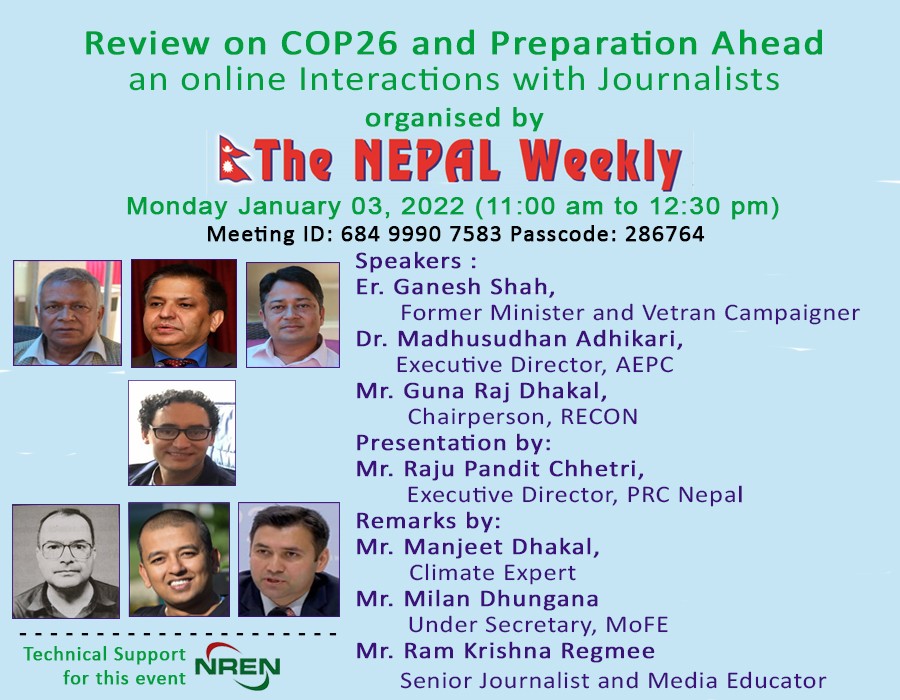 The Nepal Weekly
The Nepal Weekly  September 14, 2021
September 14, 2021National Science Day 2078
On the occasion of 9th National Science Day on September 17, 2021 Ministry of Education, Science and Technology has planned to observe National Science Day for a week starting from September 13.
Various events will be organised by the ministry during the week-long National Science Day celebration.Interaction with science experts and entrepreneurs will be some of the important events.Similarly, discussions will be held on science and diplomacy in technology by creating ‘science diplomacy forum’. People contributing to science and technology will be feted during the week-long celebration, it was shared.
Tribhuvan University, Kathmandu University, Renewable Energy Confederation of Nepal (RECON), Alternative Energy Promotion Centre (AEPC) are also preparing organise various programmes to discuss and share knowledge and experiences on renewable energy technologies suitable for Nepal.
Historically science, technology and innovation (STI) had an immense impact on ‘solving’ the challenges that come with increased modernity and consumption. However, as globalization ‘scales up’ today’s development challenges.
Science and technology pervade all aspects of modern life. Think of the impact of vaccines, mobile phones, jet travel or the internet on how we interact with one another and understand own place in society. How have theories of natural selection, advances in quantum physics, synthetic biology or new medical theories and technologies changed the way we see ourselves? How have the politics of climate change influenced the science of climate change? Scholars in Science, Technology and Innovation Studies tackle such thorny issues. We seek to answer the big questions about how societies both influence and are influenced by science, medicine and technology.
The world is moving faster with science and technologies in the age. Research and development for innovation in science and technologies is in rapid scale. The developed countries have paying more attentions and investing on innovations through R&D. The developing and under developed countries are shared the experiences on STI, though at a partial scale by the pioneers.
In the global scenario RETs have been taken as the ‘greater tools’ for reducing use of fossil fuels and biomass based fuels which are supportive to reduce climate change effects and prevent air-borne diseases. A number of global movements for promotion and development of RETs have been in the actions with ambitious objectives.
With the historical changes in the country, it has been necessary to ensure that the country’s rapid and sustainable development and making of a socialism-oriented country, research based quality education, use of innovative technology in the productive sectors, developing such environment for the scientific talents to carry out research, opportunity to exhibit inventions, ensuring enhancement of the entrepreneurship. Hence, for this, institutional re-structuring of the existing research-based institutions, development of a conducive environment for scientific research and technology and assurance of the state’s investment in research and development are essential.
The Constitution of Nepal has linked science and technology with the country’s overall and sustainable development. Accordingly, this policy has been formulated / drafted, thereby making the timely amendments to the existing policy, with an objective of boosting investment in scientific studies, research and progress and development of science and technology, protecting technical and outstanding talents and to achieve the goal of sustainable development.
Renewable energy technologies are the key element of development of socio-economics in developing countries. Nepal is one of such countries. RETs have been promoted in Nepal at different stages and scales. Micro-hydro, Solar PV, Solar thermal, Bio-gas, Improved cook stoves, bio-fuel, bio-mass carry the success stories in Nepal’s context and Wind energy has been considered as an uprising technology.
Nepal has been generating electricity from hydropower plant since 1911. Currently, the country is generating around 2,000 MW of power as the Upper Tamakoshi Hydropower Project has connected 456 MW of electricity recently. There are number of hydropower plants owned by Nepal Government and private hydropower companies are generating around 600 MW. The country has taken target to generate electricity 3000 MW, 5000 MW and 15000 MW in the next 3, 5, and 10 years respectively. Similarly, policy has been expected to shift energy mix by 20 percent electricity generated by renewable but other than hydropower technologies.
Thus, research and development activities should be carried out so as maximum utilization of Solar PV, Wind and Waste to Energy could be tapped. Technology transfer and investment are considered as the hurdles for Nepal. Therefore, policy dialogue and recommendations and opinions of experts and professionals should be taken seriously along with evidence based researches and studies. Also equally need to consider is extending support to academia and organisations working for the promotion and development of renewable energy technologies taking renewable energy technologies are key components to contribute to reduce climate change effects, reduce consumption of fossil fuels, reduce loss and damage of human life and health caused by air pollution related diseases. (The Nepal Weekly)




